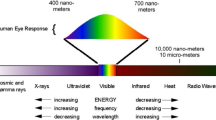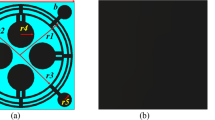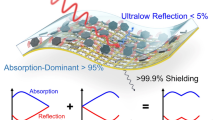Abstract
We systematically investigate the classification of incidence ways (represented by different field polarization and propagation directions of the impinging electromagnetic (EM) wave) and their influences on the EM resonant characteristics of split-ring resonators (SRRs). It is found that the resonance absorption varies noticeably with incidence ways and the variation could reach as large as 60 %, while transmittance almost keeps unchanged. When resonant electric response and resonant magnetic response are both excited in SRRs, EM resonance characteristics are found to be mainly dependent upon electric response rather than on magnetic response. The results also indicate that magnetic resonant wavelength (λ H) induced by coupled magnetic field H component of the EM wave is longer than electric resonant wavelength (λ E) induced by coupled electric field E, and the mechanism is discussed.





Similar content being viewed by others
References
Luo J, Chen H, Hou B, Xu P, Lai Y (2013) Nonlocality-induced negative refraction and subwavelength imaging by parabolic dispersions in metal–dielectric multilayered structures with effective zero permittivity. Plasmonics 8(2):1095–1099
Zhang Z, Yu M (2013) Investigation of physical limits of plasmonic focusing lens in different regions. Plasmonics 8(2):817–827
Chen H An invisibility cloak using silver nanowires. Session 1P2 transformation optics and cloaking:84
Tsakmakidis KL, Boardman AD, Hess O (2007) ‘Trapped rainbow’storage of light in metamaterials. Nature 450(7168):397–401
Hou Y (2013) Which is the interpretation of plasmon resonance in 2D split-ring resonator structure-standing wave or LC circuit? Plasmonics 8(2):665–668
Smith D, Pendry J, Wiltshire M (2004) Metamaterials and negative refractive index. Science 305(5685):788–792
Katsarakis N, Koschny T, Kafesaki M, Economou EN, Soukoulis C (2004) Electric coupling to the magnetic resonance of split ring resonators. Appl Phys Lett 84(15):2943–2945
Katsarakis N, Konstantinidis G, Kostopoulos A, Penciu R, Gundogdu T, Kafesaki M, Economou E, Koschny T, Soukoulis C (2005) Magnetic response of split-ring resonators in the far-infrared frequency regime. Opt Lett 30(11):1348–1350
Zou S, Wang G, Chen S (2013) Magnetic coupling effect on nonlinear properties in negative index metamaterials with a Kerr nonlinearity. Plasmonics 8(3):1361–1367
Linden S, Enkrich C, Wegener M, Zhou J, Koschny T, Soukoulis CM (2004) Magnetic response of metamaterials at 100 terahertz. Science 306(5700):1351–1353
Linden S, Enkrich C, Dolling G, Klein MW, Zhou J, Koschny T, Soukoulis CM, Burger S, Schmidt F, Wegener M (2006) Photonic metamaterials: magnetism at optical frequencies. Sel Top Quantum Electron, IEEE J 12(6):1097–1105
Gay-Balmaz P, Martin OJ (2002) Electromagnetic resonances in individual and coupled split-ring resonators. J Appl Phys 92(5):2929–2936
Ortuño R, García-Meca C, Martínez A (2014) Terahertz metamaterials on flexible polypropylene substrate. Plasmonics:1–5
Ricci MC, Anlage SM (2006) Single superconducting split-ring resonator electrodynamics. Applied physics letters 88 (26):264102-264102-264103
Ordal MA, Bell RJ, Alexander R Jr, Long L, Querry M (1985) Optical properties of fourteen metals in the infrared and far infrared: Al, Co, Cu, Au, Fe, Pb, Mo, Ni, Pd, Pt, Ag, Ti, V, and W. Appl Opt 24(24):4493–4499
Smith D, Vier D, Koschny T, Soukoulis C (2005) Electromagnetic parameter retrieval from inhomogeneous metamaterials. Phys Rev E 71(3):036617
Enkrich C, Wegener M, Linden S, Burger S, Zschiedrich L, Schmidt F, Zhou J, Koschny T, Soukoulis C (2005) Magnetic metamaterials at telecommunication and visible frequencies. Phys Rev Lett 95(20):203901
Klein MW, Enkrich C, Wegener M, Linden S (2006) Second-harmonic generation from magnetic metamaterials. Science 313(5786):502–504
Pendry JB, Holden AJ, Robbins D, Stewart W (1999) Magnetism from conductors and enhanced nonlinear phenomena. Microw Theory Tech, IEEE Trans 47(11):2075–2084
Tamayama Y, Yasui K, Nakanishi T, Kitano M (2014) A linear-to-circular polarization converter with half transmission and half reflection using a single-layered metamaterial. Appl Phys Lett 105(2):021110
Koschny T, Kafesaki M, Economou E, Soukoulis C (2004) Effective medium theory of left-handed materials. Phys Rev Lett 93(10):107402
Fang A, Huang Z, Koschny T, Soukoulis CM (2011) Overcoming the losses of a split ring resonator array with gain. Opt Express 19(13):12688–12699
Johnson WA, Sinclair MB, Warne LK, Langston WL, Basilio LI (2010) An effective media toolset for use in metamaterial design. Sandia National Laboratories
Tretyakov S (2007) On geometrical scaling of split-ring and double-bar resonators at optical frequencies. Metamaterials 1(1):40–43
Zhou J, Koschny T, Kafesaki M, Economou E, Pendry J, Soukoulis C (2005) Saturation of the magnetic response of split-ring resonators at optical frequencies. Phys Rev Lett 95(22):223902
Klein M, Enkrich C, Wegener M, Soukoulis C, Linden S (2006) Single-slit split-ring resonators at optical frequencies: limits of size scaling. Opt Lett 31(9):1259–1261
Lahiri B, McMeekin SG, Khokhar AZ, De La Rue RM, Johnson NP (2010) Magnetic response of split ring resonators (SRRs) at visible frequencies. Opt Express 18(3):3210–3218
Cai W, Shalaev VM (2010) Optical metamaterials, vol 10. Springer
Acknowledgments
This work was supported by the National High Technology Research and Development Program of China (No. 2013A014401), Specialized Research Fund for the Doctoral Program of Higher Education (SRFDP) (No. 20120142110064), and Natural Science Foundation of Hubei Province (No. 2012FFB02209).
Author information
Authors and Affiliations
Corresponding author
Rights and permissions
About this article
Cite this article
Min, L., Huang, L., Sun, R. et al. Incidence Ways of Electromagnetic Wave and Their Influences on the Absorption and Resonant Wavelength of Split-Ring Resonators. Plasmonics 10, 183–189 (2015). https://doi.org/10.1007/s11468-014-9792-2
Received:
Accepted:
Published:
Issue Date:
DOI: https://doi.org/10.1007/s11468-014-9792-2




